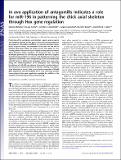| dc.contributor.author | McGlinn, Edwina | |
| dc.contributor.author | Yekta, Soraya | |
| dc.contributor.author | Mansfield, Jennifer H. | |
| dc.contributor.author | Soutschek, Jürgen | |
| dc.contributor.author | Tabina, Clifford J. | |
| dc.contributor.author | Bartel, David | |
| dc.date.accessioned | 2010-09-16T17:42:26Z | |
| dc.date.available | 2010-09-16T17:42:26Z | |
| dc.date.issued | 2009-11 | |
| dc.date.submitted | 2009-09 | |
| dc.identifier.issn | 0027-8424 | |
| dc.identifier.uri | http://hdl.handle.net/1721.1/58566 | |
| dc.description.abstract | Patterning of the vertebrate axial skeleton requires precise spatial and temporal control of Hox gene expression during embryonic development. MicroRNAs (miRNAs) are recently described modulators of gene activity, and members of the miR-196 and miR-10 families have been shown to target several Hox genes in vivo. Testing miRNA function in mice is complicated by potential redundancy between family members. To circumvent this, we have developed protocols for introducing modified antisense oligonucleotides (antagomiRs) in ovo during chick development. Using this approach, we identify a layer of regulatory control provided by the miR-196 family in defining the boundary of Hox gene expression along the anterior-posterior (A-P) embryonic axis. Following knockdown of miR-196, we observe a homeotic transformation of the last cervical vertebrae toward a thoracic identity. This phenotypic alteration is, in part, due to an anterior expansion of Hoxb8 gene expression and consolidates the in vivo relevance of posttranscriptional Hox gene regulation provided by miRNAs in the complex hierarchies governing axial pattering. | en_US |
| dc.description.sponsorship | National Institutes of Health (U.S) (R01 HD47360 ) | en_US |
| dc.description.sponsorship | National Institutes of Health (U.S) (DK068348 ) | en_US |
| dc.language.iso | en_US | |
| dc.publisher | National Academy of Sciences | en_US |
| dc.relation.isversionof | http://dx.doi.org/10.1073/pnas.0910374106 | en_US |
| dc.rights | Article is made available in accordance with the publisher's policy and may be subject to US copyright law. Please refer to the publisher's site for terms of use. | en_US |
| dc.source | PNAS | en_US |
| dc.subject | axial patterning | en_US |
| dc.subject | microRNA | en_US |
| dc.subject | homeotic transformation | en_US |
| dc.title | In ovo application of antagomiRs indicates a role for miR-196 in patterning the chick axial skeleton through Hox gene regulation | en_US |
| dc.type | Article | en_US |
| dc.identifier.citation | McGlinn, Yekta, Mansfield, Soutschek, Bartel, and Tabina (2009). In ovo application of antagomiRs indicates a role for miR-196 in patterning the chick axial skeleton through Hox gene regulation. Proceedings of the National Academy of Sciences of the United States of America 106:18610-18615. Copyright ©2010 by the National Academy of Sciences | en_US |
| dc.contributor.department | Massachusetts Institute of Technology. Department of Biology | en_US |
| dc.contributor.approver | Bartel, David | |
| dc.contributor.mitauthor | Yekta, Soraya | |
| dc.contributor.mitauthor | Bartel, David | |
| dc.relation.journal | Proceedings of the National Academy of Sciences of the United States of America | en_US |
| dc.eprint.version | Final published version | en_US |
| dc.identifier.pmid | 19846767 | |
| dc.type.uri | http://purl.org/eprint/type/JournalArticle | en_US |
| eprint.status | http://purl.org/eprint/status/PeerReviewed | en_US |
| dspace.orderedauthors | McGlinn, E.; Yekta, S.; Mansfield, J. H.; Soutschek, J.; Bartel, D. P.; Tabin, C. J. | en |
| dc.identifier.orcid | https://orcid.org/0000-0002-3872-2856 | |
| mit.license | PUBLISHER_POLICY | en_US |
| mit.metadata.status | Complete | |
